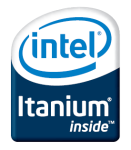eMGee wrote:
With all those high-level programming ‘object-oriented miracles’ one would need all the AMD64 CPUs that money can buy... What a wonderful market the whole ICT industry is, isn't it?
I think I'm going to give up buying anything new if the last RISC, or otherwise solid *N*X or VMS-capable and proven, architecture should at some point die off...
The following is on a minimal amount of sleep, and may not be entirely coherent.
Honestly, I don't think you need to worry. SPARC and IA64 are both seemingly at death's door, but POWER is going strong, and plenty of new chipmakers (Tilera, for example) are coming into the market. I would not be surprised to see a "RISC Renaissance" in the high end as personal computing becomes increasingly based on thin-client type technologies (like "cloud computing.") All the architectural band-aids in the world can't make x86's disadvantages go away. The really cost-sensitive segments (desktops and laptops, netbooks, etc) are already about as fast as they need to be, and will probably stick with x86 until something better (ARM?) comes along that can run the same software at a reasonable speed. On the other hand, RISC is still the fastest thing around on severs and large-scale workstations, where performance still matters, and I think that will increasingly shift in RISC's favor. x86 just isn't that fast, doesn't comfortably go above about six cores without MCM's, and in general it's I/O and memory bandwidth don't come close to RISC solutions, especially POWER. Nehalem goes a long way toward correcting this, but getting relatively close in performance to the Power6, which is last-gen, really isn't good enough.
I predict RISC workstations will, in fact, come back. I think personal computing processors over the next few years are going to be more architecturally to embedded processors than to workstation/server processors, and that personal computing will always be where Intel and (probably) AMD do the most R&D. This leaves a hole in workstation and server processors that the fast RISC chips have an excellent chance to fill. I don't think that SiCortex was the last attempt at making RISC workstations; I think it was one of the first of the new generation.
Sorry for all the run-on sentences, bizarre transitions, and non-fleshed-out ideas. I hope I get the point across.






















